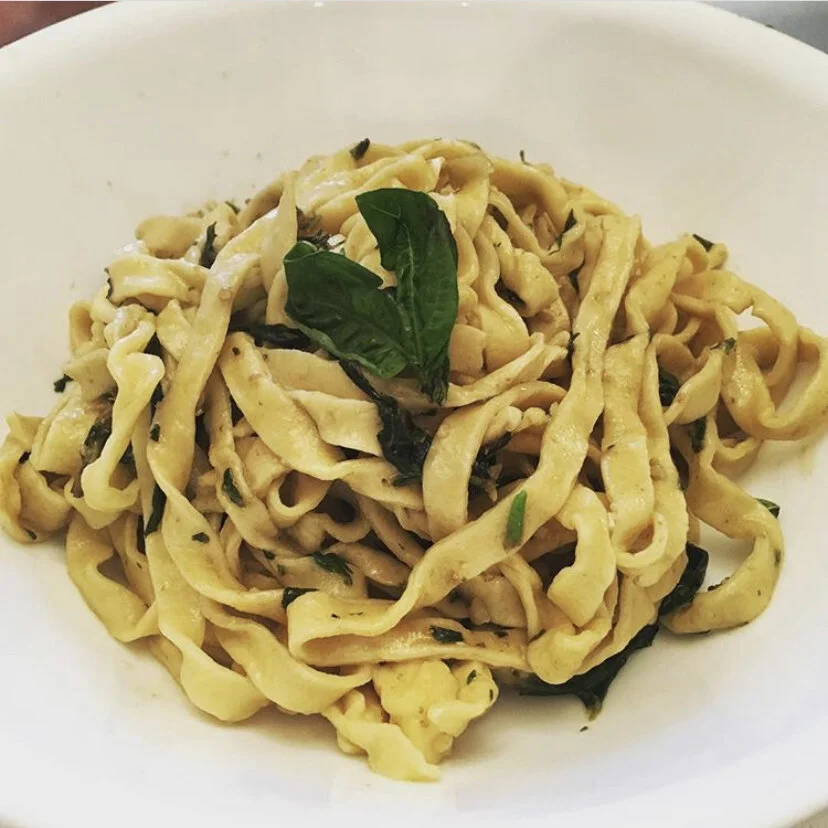Hello again, ladies and gentlemen. I hope you've had the chance to take advantage of the last sweet tomatoes of the summer, whipping up bruschette and caprese left and right. It's all about the beauty of the tricolore, as Italians refer to their famous trinity: red sweetness, white creaminess, and green muskiness.
We spotlighted the rosso element last week. Now, we turn to the verde in the tricolore, basil. I think one can best describe its flavor as being bittersweet, fresh, vaguely licorice, supremely...well...green.
The best way to harness this greenness is by preparing pesto. The dish's magic is that it blends a variety of ingredients to highlight the best elements of basil's flavor profile, while obscuring some of the less appealing elements of the leaves, which would otherwise bowl eaters over--if you'll excuse the expression--when eaten in large doses. Garlic is spicy and sulfurous; pine nuts are nutty and creamy and a little woodsy; Parm is salty and a little dairy-sweet. When they get together with Mean Green, it's a beautiful dance. Think about the Green Lantern: he's not really great if he's the star (sorry Ryan Reynolds). It's just too much green. But put him in the Justice League, with Superman and Wonder Woman and Hawk Girl, and he's a pip.
Pesto Genovese
Two ounces of basil, leaves and stems
Two cloves of garlic
Three tablespoons of pine nuts
1/4 cup Parmesan cheese
Two to four tablespoons Extra-virgin Olive Oil
One tablespoon balsamic vinegar
Salt and Pepper to taste
First, two notes on pine nuts:
Some people are hella allergic to them.
They can be expensive. But the Dell'alpe brand, which gives 2 oz for about $4, is enough to make two or three batches. So try to find those if you can, probably in the Italian section of the store. But don't pay $10. That would make me :(
If either note affects you, or someone you love, you can substitute walnuts. The flavor changes a little--walnuts are a little more bitter and less woodsy--but it's just as good. Even if you're not allergic or don't want to spend, you might want to give walnuts a try, or do a pine/walnut blend. See what you like. Experiment. Be nutty.
Now, a little history. Pesto is from Genoa, the Northern Italian port city which Christopher Columbus called home. The ingredients reflect the climes of the top of the boot: Basil likes a sunny, mountainous neighborhood; pine nuts come from pine trees. Imagine you're an alpine goat farmer in the Middle Ages. Winter hits, and then all your fresh basil is going to be buried by snow? No problem! You drenched your last green beauties in oil, thereby protecting them from microbial aggression. Congratulations. You just made basil "confit", also known as pesto.
The thriftiness of the medieval Piedmontese means that pesto is dead easy. It is actually easier than last week's dish. Ready to go? Here we go.
Place all 'dry' ingredients (reserve oil and vinegar) in a food processor or blender. Power outage? Rusty blades? Luddite? No problem. Throw all the ingredients in a mortar, and beat them to smithereens with your pestle. Done.
This is the part that gets a little technical, but still not hard. After the first blitz, you'll have a melange that looks like this:
As you can see, it's not really a paste, but more of a collection of shards of ingredients. We want to create a type of emulsion, to make sure all of the goodies get together. To that end, dump your vinegar in now. Now, you're gonna add olive oil a tablespoon at a time, blitz the mix, add another until your pesto is pestoey:
Perfection.
"Why the balsamic?" you may ask. If you read last week's entry, the balsamic does double duty. It tastes amazing. It also gives an acidic/aqueous phase to our solution. That allows us to do some awesome organic chemistry. The oil allows us to extract essential oils from the basil. Some of the delicious little compounds in basil, however, are only water-soluble. Vinegar will allow them to be able to flow out of the battered-leaf fragments into the flavorful matrix.
This chemical reality is going to be very helpful in a few minutes, cause I'm not going to put this in the fridge, where it can stay for a very long time, ready to be deployed as a marinade for chicken or sandwich condiment or dip for your pizza. I'm grubbing RIGHT NOW. Here we go.
I just tossed some cubes of mozzarella cheese (our bianco) with the pesto to get them happy together. Some linguine is boiling in salty water nearby. I will drain them when they are al dente (to the tooth), which means they still have a bit of chew, about 8-9 minutes, but I will reserve about a half a cup of that cooking water. Now the magic:
Dump that hot pasta into the bowl and toss like mad. Pour a touch of that cooking water into the bowl. It may look a little wet. Keep tossing. What is happening? The hot linguine (literally, "little tongues) are lapping up the solution in the bowl. We're really happy we put some balsamic in the mix right now, because the tasty water-soluble compounds are now within the pasta. The heat is melting the mozzarella. It's an amazing thing to behold.
I garnish it up with some cherry tomatoes that I tossed with olive oil and roasted in the oven at 400 degrees for about 30 minutes. I take a quick picture for you people, throw my phone down, and tuck in.
Thus ends our salute to the Mean Green in the Italian flag. Enjoy it. I can only hope that while chowing down, you think a little bit harder about how cool the Green Lantern actually is.








